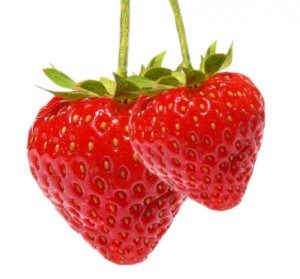
When you think of berries, the strawberry is most likely the first one to come to mind. Therefore, it might come as a surprise to find out that, botanically speaking, they are not actually a part of the berry world. “True berries are simple fruits stemming from one flower with one ovary and typically have several seeds,” according to Greta Lorge’s article “Bananas Are Berries?” The strawberry comes from a flower that carries more than one ovary, in addition to not having seeds on its body – the little dots on the outside of the strawberries are actually a type of dry fruit (achene), which carries its own seed inside it, according to Lynn Parrucci and Amy Eubanks’s article “The Strawberry: A Multiple Fruit.” This makes the strawberry an aggregate or accessory fruit, but not a berry. This is not the only interesting attribute about this little fruit. The most popular type of strawberries that you see and buy every day at grocery stores are not all-natural grown fruits. They are considered a hybrid species, created by the marriage of two other types of wild strawberries: the Chilean Fragaria chiloensis, and the North American Fragaria Virginiana, according to the book Strawberry – History, Breeding and Physiology.
The first knowledge of this hybrid species was in the early 1700’s, in France, when the only type of strawberry in the country’s existence was the wild Fragaria vesca. This varietal was very small but incredibly sweet and flavorful. The French found in the American strawberry what they didn’t have in their native one: size. The idea of creating a perfect combination of flavor and size gave modern society the strawberries it knows today. As time passed, in order to maintain the look, shelf-life, expectancy and flavor, a new cross-breed was needed to remedy it. Wild strawberries are considered species without any type of cross breeding; they are grown from the soil without any human intervention. These carry a stronger and sweeter taste, much like the very first French species, but they also have a short shelf-life after picked, which makes them more rare.
Wild or not, this fruit will always taste sweeter when picked right off the plant. The natural sugars in strawberries starts to convert into starch as soon as they are picked off of the plant – that is why grocery store strawberries tend to taste tart with a grainy texture, according to The Old Farmer’s Almanac.
Still, strawberries are one of the favorite and most popular fruits of them all. In today’s market, there is strawberry flavored everything: cakes, ice cream, pies, sauces, lipstick, toothpaste, and so on. The United States Department of Agriculture affirms that Americans each consume 4.85 pounds of fresh and frozen strawberries per year. California is responsible for 75 percent of the strawberry crops in the country, according to Ron Wolford and Drusilla Banks’s dedicated study “Strawberries & More” for the University of Illinois Extension. And speaking of favorites, the same study shows that 53 percent of children between 7-9 years old name strawberries as their favorite fruit.
All the love devoted to this fruit is understandable. Aside from its deliciousness, strawberries have numerous health benefits. For starters, they are the second most efficient fruit type for preventing breast cancer, losing only to grapes, as Dr. Michael Greger M.D. mentions in his article “Breast Cancer and Wine.” Strawberries are also loaded with vitamin C, are sodium free, fat free, cholesterol free, saturated fat free and are high in folate, according to the Fruit & Veggies More Matters® Initiative. No matter the type of strawberry, wild or hybrid, this is one of the heathiest and most delicious fruits in the world.
